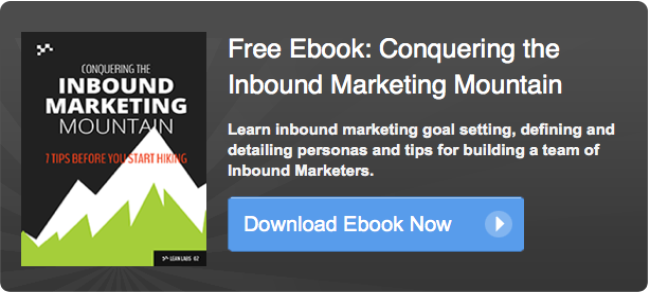 As a profession, inbound marketing is demanding. We’re tasked with social media monitoring and engagement, scheduling organic posts, budgeting and executing paid placements, building relationships with and guest posting on others’ properties, maintaining an active email marketing program, optimizing everything we touch for search and conversions, analyzing data, and always coming up with killer creative and constant reinvention of the wheel for the latest strategies, technologies, tactics and channels. It’s enough to make you dizzy!
As a profession, inbound marketing is demanding. We’re tasked with social media monitoring and engagement, scheduling organic posts, budgeting and executing paid placements, building relationships with and guest posting on others’ properties, maintaining an active email marketing program, optimizing everything we touch for search and conversions, analyzing data, and always coming up with killer creative and constant reinvention of the wheel for the latest strategies, technologies, tactics and channels. It’s enough to make you dizzy!
So it makes sense that inbound marketers might slip into some less-than-optimal patterns over time. It’s understandable - go on and forgive yourself. Once you're self aware of these pitfalls, use the following tricks to break free of these bad habits.
We’ve found the following tips to be super helpful and hope you do too.
1) Flying Blind
We all slip into “spazz whirlwind mode” every once in a while. You know what I’m referring to - that state of work consciousness where you jump from urgent task to urgent task, never thinking strategically about the big picture of your time use.
The problem here is that when you let yourself get swept away like that, you lose your ability to effectively judge what truly is the most important task to focus on, and you end up missing deadlines, not sleeping enough and under-delivering when it comes to quality.
Focusing on tactics without the context of an overarching strategy is trouble. Research demonstrates that marketers who work with documented strategies have more confidence in their work and are more focused on the way their audience engagement efforts support the company’s marketing goals.
And besides, the best creative ideas come to us when we’re in relaxed mode, so make sure you don’t spazz yourself into burnout!
The solution: Work with 90-day marketing strategy plans. Every quarter, evaluate and document what you’ve done, what your goals for the coming months are, and what tactics you’ll use to support these goals.
Keep the goals ambitious but realistic and concrete. Get all of the stakeholders from your project on the same page with the strategy document, and keep it handy, so you can refer back to it as you work. Create recurring and one-off calendar reminders for the various benchmarks and tasks involved with pushing the strategy forward, and constantly reconcile how you’re spending your time with your strategy document and with your calendar.
2) Forgetting CTAs
Studies show that calls-to-action are alarmingly underused on business websites. But making it super clear what you want the user to do in every context can make the difference between inbound success and failure. Smart marketers are increasingly publishing single-page microsites with minimalist design, aimed at doing little more than converting with prominent CTAs. And CTAs are among the most popular elements for marketers to A/B test with.
Onsite content is just the beginning, of course. Depending on your business goals, well-thought-out CTAs should appear in pretty much every message you put out there. Facebook even allows Pages to embed custom CTA buttons in posts.
Don’t get so caught up with your geo-targeting tools, article research, customer support tweet replies and Google Plus scheduling that you overlook CTAs.
The solution: Keep a running document or archive of creative examples of CTAs. You can use Google Documents to paste URLs or screenshots, use a dedicated tag in Evernote to store web clips, a browser bookmarks folder, a private Pinterest board, or whatever other technical solution you like best for storing web content for later reference.
The main point is to keep you thinking about CTAs and noticing them everywhere you look. With CTAs always on your mind, you’re more likely to remember to use them in your own marketing messages. A great way to jump start these efforts is to browse through HubSpot’s awesome 101 Examples of Effective Calls-to-Action ebook.
3) Being a Perfectionist
What if you finally click the “Publish” button only to realize two hours later that you could have made whatever it is you’re working on even better? For many of the players in the digital world, this is a very real fear that keeps products from going live.
But it’s an outdated way of thinking, and you need to make sure it doesn’t hold you back. It’s silly when you think about it - especially if your product is fully digital, which means it’s relatively easy to upgrade regularly. If you come up with something you want to add to a piece of content you’ve already published, add it! Do you really need the engineers down the hall to roll out that new feature before you tell the world about your brand? Probably not, and you can always send out another message letting your audience know about the next release.
The solution: Keep it lean, and keep it agile! Start by reading Getting Real, the 2009 wake up call page turner by Jason Fried of Chicago’s 37signals. Thanks to its no-nonsense tone and memorable takeaways (launch today!), this short book will give you a solid foundation for starting to let go of your perfection anxieties.
Get to know the theories of lean and agile methodologies, which will teach you that as long as you don’t weigh yourself down with unnecessary processes, you can constantly iterate. Stop trying to invent the greatest thing since sliced bread. Just ship it, measure the impact and reactions, tweak and repeat!
4) Neglecting Your Personas
Traditional media marketers used extremely basic and crude target audience demographic factors to help them make decisions about spray-and-pray paid placements. Nowadays, digital media marketers can target users according to so many factors, it’s often mind-boggling. and regardless of the tools at our fingertips, the most effective inbound marketing messages are written with an audience consisting of one person in mind.
If you constantly develop and refine the characteristics of your brand’s buyer personas, then you’ll be able to imagine you’re speaking directly to these fictional individuals as you write, and your content will be the better for it. If you can map out your personas’ individual motivators and challenges as they move along the decision making process, then you can ensure that your marketing is as helpful as possible for keeping your audience engaged and progressing towards lasting relationships with your brand.
The solution: Remember that personas aren’t one-off theoretical exercises - they’re works in progress meant to help you do your job well every day. Maintain documents for your personas and schedule monthly reviews so that you build regular persona updates into your routine, incorporating your company’s latest research and user patterns into the documents.
Every time you complete a monthly review, print out the latest versions of your persona documents and hang them on the wall next to your desk. Nothing helps you focus on the audience member you’re addressing like looking right at her or him.
5) Losing Sight of Your Unique Value Proposition
With inbound, you’re meant to sell by being helpful and generous rather than sales-y. You discuss benefits rather than features to evoke emotions instead of technicalities. You delve into realms that happen to be important to our audience, even if these have zero literal connection to your product.
It makes sense that you might forget that the brand you represent offers a real product with a distinct niche and that everything you do should come back to that. Don’t confuse being a shrewd, community-first marketer with beating around the bush. Good inbound marketing stays close enough to the product being marketed that the product’s unique value proposition (UVP) is always part of the conversation.
The solution: It all comes back to your constantly updated persona and strategy documents. Your inbound marketing messages should always be manifestations of the talking points called for therein - talking points that you’ve conceived of with your brand’s UVP in mind.
It's Your Turn!
Ready to shed those unhealthy patterns? Systemize everything you do so that you have time to reflect. Make sure you don’t fall into the “too busy” trap and start forgetting about the fundamentals of inbound methodology.
The workflow hacks that work well for our team here at Lean Labs won’t necessarily be the best solutions for everyone. Got any tips of your own to share? Think we missed something? Let us know in the comments below!
This post originally appeared on the Lean Labs blog. Lean Labs is a HubSpot Partner located in Overland Park, KS.


